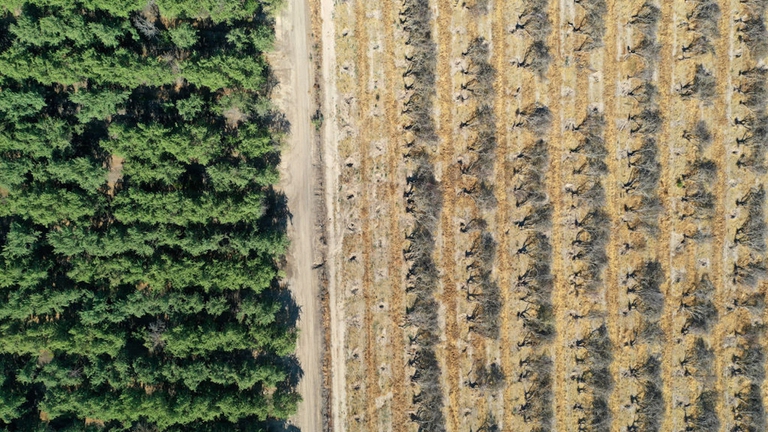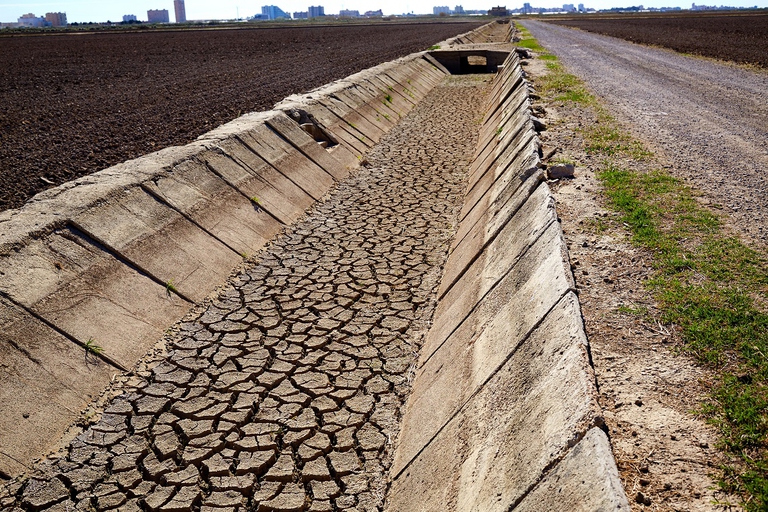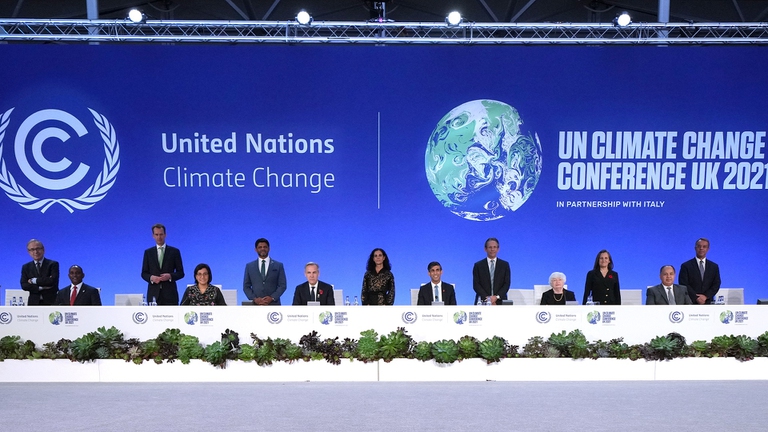
South African court dismisses a major lawsuit by 140,000 Zambian women and children against Anglo American for Kabwe lead poisoning. A setback for affected communities enduring the lasting impact of lead contamination.
In Glasgow, technological solutions to climate change have been cleared as “natural” but are in contrast with regenerative, biodiversity-centred solutions.
Changes to climate and their physical consequences cannot be addressed without recognising the central role of the industrial, globalised food system, both in its contribution to and perpetuation of the climate crisis and in its creation of vulnerable agri-food systems around the world. The industrial agricultural system is characterised by the use of hybrid or commercial GMO seeds, by the cultivation of monocultures based on the use of chemical products derived from fossil fuels, by intensive animal farming, and by changes in land use, which cause problems such as large-scale deforestation.
Food produced by the industrial agricultural system then enters the global processing and transport markets, which creates enormous quantities of food waste. Fossil fuels are used throughout almost every stage of the food chain, from fossil-based chemicals in the form of pesticides and synthetic fertilisers, to fuel-consuming agricultural equipment, and the massive global processing, packaging and transportation system.
All combined, these ecologically destructive practices account for 44 per cent to 57 per cent of total greenhouse gas emissions, making the global food system a major contributor to global warming and environmental degradation. The climate crisis is the result of indifference and an inability to understand Earth’s ecosystems, incapacities sustained by a profit-oriented mindset. This same mentality has allowed agribusiness to invade forests and other vital ecosystems, making this industry responsible for 70 to 90 per cent of global deforestation and for displacing indigenous populations.
Among the main victims of the modern agricultural paradigm is agrobiodiversity. Today, about 80 per cent of the world’s arable land is organised in monocultures of uniform and genetically identical crops. This has caused an unprecedented extinction to both agrobiodiversity and wild biodiversity, making ecosystems and food security even more vulnerable to climate change. Evidence is growing that artificial fertilisers have reduced soil fertility and crop yields and contributed to desertification, water scarcity and therefore, also to global warming. Land treated with chemical fertilisers and depleted of organic carbon and nutrients loses its ability to hold water, making these areas more vulnerable to droughts and flooding. They also create a perpetual need to use greater amounts of water and chemicals to replace nutrient depletion. This has aggravating effects on ecosystems as the use of nitrogen fertilisers also leads to the pollution of water sources, desertification, and soil degradation.
Faced with the looming climate emergency, world leaders gathered in Glasgow for the United Nations Climate Conference (COP26), from October 31 to November 12, to define an action plan to address the crisis. Among the main objectives of the summit was a commitment to increase technology funding, aiming to increase climate resilience and reduce global greenhouse gas emissions, in order to keep the increase in global average temperatures below 1.5 degrees by the end of the century. After a week, COP26 had already been called the most exclusive and inaccessible climate conference ever and had received widespread criticism from activists and civil rights groups who questioned its legitimacy. More than 100,000 people mobilised to protest COP26, giving rise to more than 300 demonstrations around the world that denounced false solutions to the problem and demanded greater participation in climate justice.
Most of the events took place behind closed doors, featuring talks by world leaders who repeated trite speeches on greenhouse gas reduction and climate finance. Philanthropists and big tech investors were in the spotlight, rather than civil rights groups and marginalised communities. This perfectly illustrates the position taken by COP26: a commitment to technological solutions instead of regenerative and biodiversity-centric solutions.
COP26 proved to be yet another failed attempt to hold polluting companies accountable for their actions, conforming to the false solutions to climate change that they advocate. The conference served as a corporate greenwashing arena, a place to reframe major players in big tech and industrial agriculture as heroes providing solutions to climate change, instead of rightly identifying them as the culprits. Rather than reversing current trends, everything seems to lead to further digitalisation of agriculture, more climate-resistant GMO crops, artificial and lab-grown foods, carbon credits, and other false solutions that do not address the primary causes of global warming.
The solutions proposed by these “climate lords” consist of expensive, inadequately tested, and often dangerous technological innovations, such as food produced artificially in laboratories, gene editing, CO2 capturing, carbon credits and geoengineering. These are all aimed at replacing natural processes and they completely ignore the power of nature, denying its regenerative abilities. Yet, despite this, they are backed by multinationals and big-tech investors, who market them as the only possible solution to the climate crisis. False solutions and biotechnology shift political power from organic farmers and local communities to biotech companies and large investors. They do not take into account local, indigenous knowledge and different food cultures that have evolved together with local ecosystems over time.
The concept behind “net-zero” is to balance greenhouse gas emissions with their capture and removal from the atmosphere. To reach zero, the amount of emitted CO2 cannot be greater than the amount removed in the same time period. This equation is problematic because it implies the possibility for companies to reach net-zero by investing in CO2 offsetting schemes. However, net-zero will not lead to actual emission reductions, for several reasons. Firstly, this approach focuses only on emission streams and does not consider the cumulative nature of CO2. Carbon dioxide stays in the atmosphere for hundreds or even thousands of years unless stored elsewhere. This means that past, present, and future emissions have a cumulative impact on both global warming and ocean acidification. Secondly, offsets do not actually reduce atmospheric CO2 concentrations. Carbon dioxide levels will therefore continue to rise at an alarming rate if they are not effectively absorbed by soils and oceans.
In reality, net-zero is nothing more than an elaborate industrial greenwashing scheme that grants polluting companies the right to expand their operations and continue to pollute, while capturing CO2 elsewhere. By offsetting their emissions through planting monoculture tree plantations, companies will continue to trigger land grabbing and the displacement of communities, human rights abuses, water scarcity, and further biodiversity loss. These so-called nature-based solutions divert attention from the root causes of the climate and health crisis. This is a dangerous tactic that delays radical intervention, allowing multinationals, governments and financial institutions to continue to operate as usual, without addressing the causes of the problem. These ‘nature-based’ solutions exploit nature through the transactional logic of market mechanisms and externalise ecological destruction through compensation projects.
The idea behind geoengineering is to employ a range of technologies to deliberately intervene in the earth’s climate system and alter it. For example, the Bill and Melinda Gates Foundation and Harvard University are working together to fund a plan to introduce sulfate aerosols into the atmosphere in order to block sunlight. In theory, the use of these chemicals to block incoming sunlight would reduce the problem of global warming, giving us more control over the climate. However, the warming effect of carbon dioxide on the atmosphere can persist for up to ten thousand years. It is believed that particles capable of attenuating the effects of the sun leave the atmosphere after about a year, which means that in order for this technology to be effective, it would be necessary to continuously pump the atmosphere with chemical aerosols.
By definition, geoengineering aims to alter planetary systems such as the carbon cycle and the water cycle, but it does nothing to address the root causes of climate change. The solutions illustrated so far are the product of a mechanistic world view that sees nature as dead, inert matter that can be engineered and manipulated to adapt to our needs and favour the interests of large companies. By putting technological innovations on a pedestal and presenting them as the only viable option to solve the world’s many crises, large multinationals are setting their own priorities and further cementing their control. This reluctance to address systemic issues is by no means coincidental. Rather, it’s a deliberate attempt by multinationals to maintain control by perpetuating the same power structures that created the current crisis, without taking any responsibility for large scale pollution and environmental degradation. This is not the transition we need. The goal should not only be to capture CO2, but should rather be to enhance the overall health of our ecosystems and people, including the fostering of healthy livelihoods and economies, and the creation of equity and justice. We need to protect our forests, safeguard biodiversity, and thus establish health and climate resilience.
Unlike the false promises made by multinational corporations and billionaire investors, true solutions to climate change should not seek to engineer or manipulate our planet for profit. On the contrary, they should aim to work alongside nature to restore its biodiversity and regenerate its natural cycles. These solutions already exist and are being pursued by local food communities around the world, showing us that a way to live in harmony with nature is possible. The biodiversity of plants, animals and microorganisms is the key to providing the stability and balance needed to create resilient agroecosystems and to tackle climate change. The same food and agricultural systems that conserve and regenerate biodiversity also mitigate global warming and contribute to good health and improved livelihoods through living and regenerative economies.
Agroecology is based on a wide range of principles and includes methods that work in harmony with nature, regenerating biodiversity through living seeds and soils, supporting local food communities, and avoiding the use of chemicals derived from fossil fuels. Agroecological systems are designed to mimic natural processes and regenerate biodiversity in order to provide ecological services such as natural pest control, nutrient cycling, regeneration and improvement of soils, increased CO2 capturing and increased water concentration in soils. By focusing on local agriculture and moving production away from globalised supply chains, these systems are able to replace fossil fuel-intensive methods with low-input, regenerative systems that strengthen the soil and put carbon back into it. Agroecosystems thus maintain their climate regulation functions and are able to mitigate the effects of climate change.
By working with nature, regenerative agriculture and agroecology can generate greater food resilience by taking carbon dioxide from the atmosphere and putting it back into the soil through photosynthesis. Increasing CO2 capture in soils is a vital part of mitigating climate-related problems. Agroecological solutions represent a move away from the industrial food system and embrace a different view of the food transformation system. They are based on a systemic approach, a deep understanding of the life cycles of nature and the Earth, and involve changes at the political, social, and economic levels. The agroecological transformation is incompatible with the paradigm of industrial agriculture, as it requires a complete departure from the hyper-centralised industrial food system controlled by multinationals. Any compromise, such as resorting to ecological techniques and practices that do not change the monoculture model of industrial agriculture, can only temporarily moderate negative impacts, while directly contributing to further climate crises in the long run. True transformation can therefore only occur through a transition to agroecological food systems.
Siamo anche su WhatsApp. Segui il canale ufficiale LifeGate per restare aggiornata, aggiornato sulle ultime notizie e sulle nostre attività.
![]()
Quest'opera è distribuita con Licenza Creative Commons Attribuzione - Non commerciale - Non opere derivate 4.0 Internazionale.
South African court dismisses a major lawsuit by 140,000 Zambian women and children against Anglo American for Kabwe lead poisoning. A setback for affected communities enduring the lasting impact of lead contamination.
Controversial African land deals by Blue Carbon face skepticism regarding their environmental impact and doubts about the company’s track record, raising concerns about potential divergence from authentic environmental initiatives.
Majuli, the world’s largest river island in Assam State of India is quickly disappearing into the Brahmaputra river due to soil erosion.
Food imported into the EU aren’t subject to the same production standards as European food. The introduction of mirror clauses would ensure reciprocity while also encouraging the agroecological transition.
Sikkim is a hilly State in north-east India. Surrounded by villages that attracts outsiders thanks to its soothing calmness and natural beauty.
Sikkim, one of the smallest states in India has made it mandatory for new mothers to plant saplings and protect them like their children to save environment
Chilekwa Mumba is a Zambian is an environmental activist and community organizer. He is known for having organized a successful lawsuit against UK-based mining companies.
What led to the Fukushima water release, and what are the impacts of one of the most controversial decisions of the post-nuclear disaster clean-up effort?
Nzambi Matee is a Kenyan engineer who produces sustainable low-cost construction materials made of recycled plastic waste with the aim of addressing plastic pollution and affordable housing.












